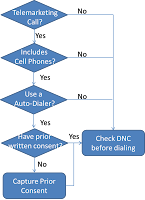For a lot of telemarketers, TCPA is a four letter word.
That's because on October 16 this little known FCC regulation got a whole lot stricter. Already considered onerous by many in the industry, the revised TCPA rules require telemarketers to gather a customers written consent prior to making auto-dialer assisted calls or texts to their cell phones. A mix of ambiguity and an out of dated understanding of mobile technology and adoption, the TCPA has a lot companies and Call Centers scrambling to sustain live agent outbound sales calls that are essential to their business model.

Another example of restrictive government? Perhaps.
Time to Panic? Maybe
The end of telemarketing? No.
Perhaps its even a new beginning.
What the TCPA is doing for telemarketing is something that SMS has already adopted and email marketing may also adopt in the near future: permission based marketing. Earning the right to connect with a customer is something that every business must do every day. While the spray and pray strategy can yield results in the short term, there is too much risk for a few bad actor companies to ruin it for everyone else. Indeed, with the Do Not Call registry above 200 Million US residents, the share of available targets gets smaller every day.
Instead, successful companies must blend content relevance, quality and accessibility to deserve a place in the clutter of over 300 emails, calls, SMS, direct mail, and other marketing ploys the average customer receives every day. In essence, this is a flight from lead quantity to quality.
While companies who rely on outbound marketing calls should definitely consult with a expert legal team and connect with industry associations who focus on the topic, here are some tips for companies who are going through their own TCPA adoption pains.
TCPA Tips for Telemarketing Die-hards

Remember, its up to you to use the new more strict TCPA regulations as a hinderence or a competitive advantage. If you can craft a strategy to achieve and maintain written consent, you will have access to customers in channels your competitors do not and a platform for an honest and meaningful dialogue. Striving for relevant, value add interaction is the only way companies can stay ahead of the tidal wave of incidental marketing and evolve a personal relationship with the customer on their terms.
That's because on October 16 this little known FCC regulation got a whole lot stricter. Already considered onerous by many in the industry, the revised TCPA rules require telemarketers to gather a customers written consent prior to making auto-dialer assisted calls or texts to their cell phones. A mix of ambiguity and an out of dated understanding of mobile technology and adoption, the TCPA has a lot companies and Call Centers scrambling to sustain live agent outbound sales calls that are essential to their business model.

Another example of restrictive government? Perhaps.
Time to Panic? Maybe
The end of telemarketing? No.
Perhaps its even a new beginning.
What the TCPA is doing for telemarketing is something that SMS has already adopted and email marketing may also adopt in the near future: permission based marketing. Earning the right to connect with a customer is something that every business must do every day. While the spray and pray strategy can yield results in the short term, there is too much risk for a few bad actor companies to ruin it for everyone else. Indeed, with the Do Not Call registry above 200 Million US residents, the share of available targets gets smaller every day.
Instead, successful companies must blend content relevance, quality and accessibility to deserve a place in the clutter of over 300 emails, calls, SMS, direct mail, and other marketing ploys the average customer receives every day. In essence, this is a flight from lead quantity to quality.
While companies who rely on outbound marketing calls should definitely consult with a expert legal team and connect with industry associations who focus on the topic, here are some tips for companies who are going through their own TCPA adoption pains.
TCPA Tips for Telemarketing Die-hards

- When do I need to capture prior written consent? Take a look at the decision tree here to see if you are impacted.
- How do I capture prior written consent This one is more tricky. TCPA guidelines are specific in that consent bust be clear and obvious, preferably next to where you are capturing the actual telephone #. You must also explicitly state the potential use of an automated dialer and be specific to what company entity the consent applies.
- How do I avoid scaring away my customers? Stay close to why customers are giving their #s to you in the first place and be sure to focus on addressing that expectation.
- Are there additional ways to maximize consent opt-in? Best in class companies are are building trust by setting some boundaries, including
- When you will contact them (provide a time range to balanc eoperational capacity with customer convenience)
- Maximum frequency: How many times a day/week do you plan to try them?
- Opportunity to opt-out: Including the details on how to opt-out
- Alternative channels: Get the customer to share (and opt-in) to their preferred channels
Remember, its up to you to use the new more strict TCPA regulations as a hinderence or a competitive advantage. If you can craft a strategy to achieve and maintain written consent, you will have access to customers in channels your competitors do not and a platform for an honest and meaningful dialogue. Striving for relevant, value add interaction is the only way companies can stay ahead of the tidal wave of incidental marketing and evolve a personal relationship with the customer on their terms.
Telemarketing provide a more interactive and personal sale service.
ReplyDeleteReally a great addition. I have read this marvelous post. Thanks for sharing information about it. I really like that. Thanks so lot for your convene. bulk sms ahmedabad provider
ReplyDelete